engine YAMAHA WR 250R 2012 Owners Manual
[x] Cancel search | Manufacturer: YAMAHA, Model Year: 2012, Model line: WR 250R, Model: YAMAHA WR 250R 2012Pages: 98, PDF Size: 2.57 MB
Page 6 of 98

TABLE OF CONTENTSSAFETY INFORMATION .................. 1-1
DESCRIPTION .................................. 2-1
Left view .......................................... 2-1
Right view ........................................ 2-2
Controls and instrument s................. 2-3
INSTRUMENT AND CONTROL
FUNCTIONS ....................................... 3-1
Main switch/steering lock ................ 3-1
Indicator lights and warning
lights ............................................ 3-2
Multi-function display ...................... 3-3
Handlebar switches ........................ 3-8
Clutch lever ..................................... 3-9
Shift pedal ...... ............................. .. 3-10
Brake lever ................................... 3-10
Brake pedal .................................. 3-10
Fuel tank cap ................................ 3-11
Fuel ............................................... 3-11
Catalytic converter ........................ 3-13
Seat .............................................. 3-13
Helmet holder ............................... 3-14
Adjusting the front fork .................. 3-14
Front fork bleeding ........................ 3-16
Adjusting the shock absorber assembly ................................... 3-17
EXUP system ............................... 3-18
Sidestand ...................................... 3-19
Ignition circuit cut-off system ........ 3-19 FOR YOUR SAFETY
–
PRE-OPERATION CHECKS ............. 4-1
OPERATION AND IMPORTANT
RIDING POINTS ................................. 5-1
Starting the engine ......................... 5-1
Shifting ........................................... 5-2
Tips for reducing fuel consumption ............................... 5-3
Engine break-in .............................. 5-3
Parking ........................................... 5-4
PERIODIC MAINTENANCE AND
ADJUSTMENT ................................... 6-1
Owner’s tool kit ............................... 6-2
Periodic maintenance chart for the emission contro l system ....... 6-3
General maintenance and lubrication chart .......................... 6-4
Removing and installing panels ..... 6-8
Checking the spark plug ............... 6-11
Engine oil and oil filter element .... 6-12
Coolant ......................................... 6-14
Cleaning the air filter element and check hose ......................... 6-17
Adjusting the engine idling speed ........................................ 6-19
Checking the throttle grip free
play ........................................... 6-19
Valve clearance ............................ 6-20
Tires ............................................. 6-20 Spoke wheels ............................... 6-22
Adjusting the clutch lever free
play ............................................ 6-22
Adjusting the brake lever free play ............................................ 6-23
Checking the shift pedal ............... 6-24
Brake light switches ...................... 6-24
Checking the front and rear brake pads ................................. 6-25
Checking the brake fluid level ....... 6-25
Changing the brake fluid ............... 6-26
Drive chain slack ........................... 6-27
Cleaning and lubricating the drive chain ................................. 6-28
Checking and lubricating the cables ........................................ 6-29
Checking and lubricating the
throttle grip and cable ................ 6-29
Checking and lubricating the brake and clutch levers ............. 6-29
Checking and lubricating the brake pedal ................................ 6-30
Checking and lubricating the
sidestand ................................... 6-30
Lubricating the swingarm
pivots ......................................... 6-31
Checking the front fork .................. 6-31
Checking the steering ................... 6-32
Checking the wheel bearings ........ 6-32
Battery .......................................... 6-32
Replacing the fuses ...................... 6-3432D-9-E8.book 1 ページ 2011年6月28日 火曜日 午前10時27分
Page 9 of 98
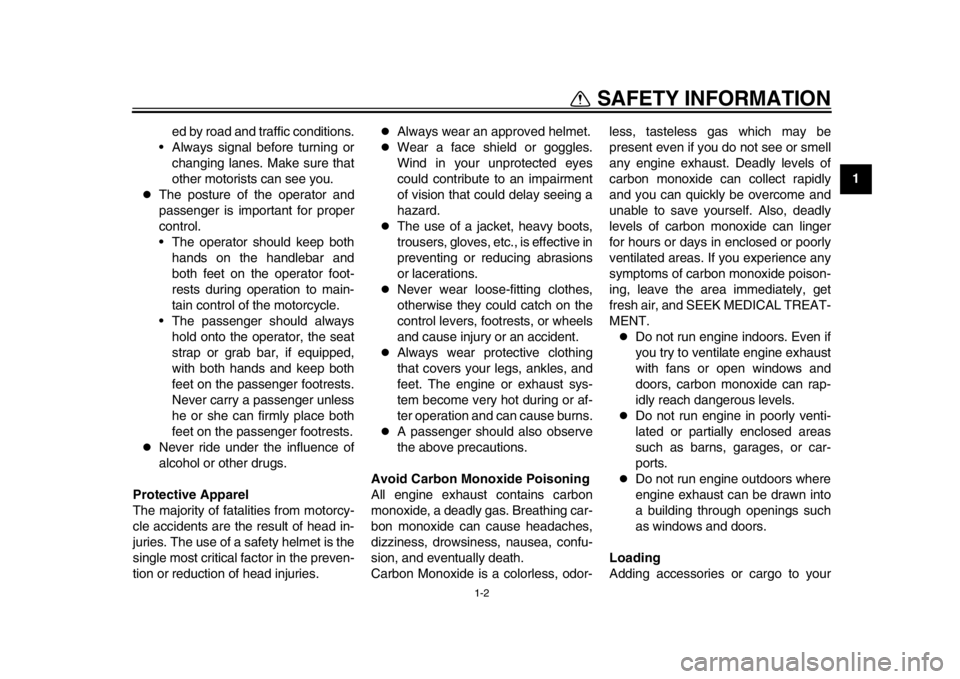
1-2
1
SAFETY INFORMATION
ed by road and traffic conditions.
• Always signal before turning or
changing lanes. Make sure that
other motorists can see you.
The posture of the operator and
passenger is important for proper
control.
•The operator should keep both
hands on the handlebar and
both feet on the operator foot-
rests during operation to main-
tain control of the motorcycle.
• The passenger should always
hold onto the operator, the seat
strap or grab bar, if equipped,
with both hands and keep both
feet on the passenger footrests.
Never carry a passenger unless
he or she can firmly place both
feet on the passenger footrests.
Never ride under the influence of
alcohol or other drugs.
Protective Apparel
The majority of fatalities from motorcy-
cle accidents are the result of head in-
juries. The use of a safety helmet is the
single most critical factor in the preven-
tion or reduction of head injuries.
Always wear an approved helmet.
Wear a face shield or goggles.
Wind in your unprotected eyes
could contribute to an impairment
of vision that could delay seeing a
hazard.
The use of a jacket, heavy boots,
trousers, gloves, etc., is effective in
preventing or reducing abrasions
or lacerations.
Never wear loose-fitting clothes,
otherwise they could catch on the
control levers, footrests, or wheels
and cause injury or an accident.
Always wear protective clothing
that covers your legs, ankles, and
feet. The engine or exhaust sys-
tem become very hot during or af-
ter operation and can cause burns.
A passenger should also observe
the above precautions.
Avoid Carbon Monoxide Poisoning
All engine exhaust contains carbon
monoxide, a deadly gas. Breathing car-
bon monoxide can cause headaches,
dizziness, drowsiness, nausea, confu-
sion, and eventually death.
Carbon Monoxide is a colorless, odor- less, tasteless gas which may be
present even if you do not see or smell
any engine exhaust. Deadly levels of
carbon monoxide can collect rapidly
and you can quickly be overcome and
unable to save yourself. Also, deadly
levels of carbon monoxide can linger
for hours or days in enclosed or poorly
ventilated areas. If you experience any
symptoms of carbon monoxide poison-
ing, leave the area immediately, get
fresh air, and SEEK MEDICAL TREAT-
MENT.
Do not run engine indoors. Even if
you try to ventilate engine exhaust
with fans or open windows and
doors, carbon monoxide can rap-
idly reach dangerous levels.
Do not run engine in poorly venti-
lated or partially enclosed areas
such as barns, garages, or car-
ports.
Do not run engine outdoors where
engine exhaust can be drawn into
a building through openings such
as windows and doors.
Loading
Adding accessories or cargo to your
32D-9-E8.book 2 ページ 2011年6月28日 火曜日 午前10時27分
Page 11 of 98
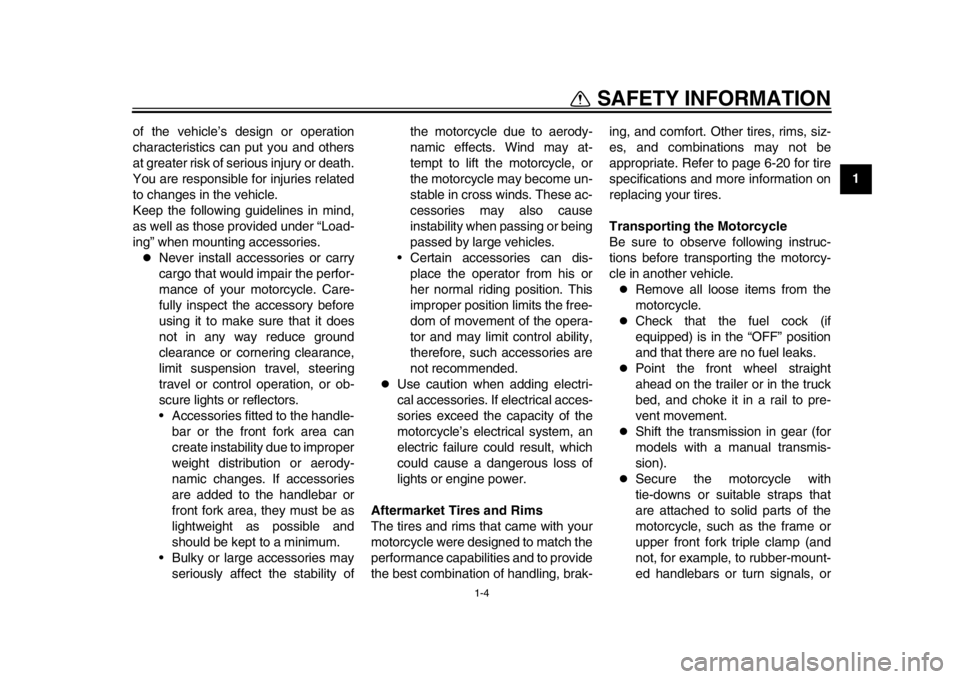
1-4
1
SAFETY INFORMATION
of the vehicle’s design or operation
characteristics can put you and others
at greater risk of serious injury or death.
You are responsible for injuries related
to changes in the vehicle.
Keep the following guidelines in mind,
as well as those provided under “Load-
ing” when mounting accessories.
Never install accessories or carry
cargo that would impair the perfor-
mance of your motorcycle. Care-
fully inspect the accessory before
using it to make sure that it does
not in any way reduce ground
clearance or cornering clearance,
limit suspension travel, steering
travel or control operation, or ob-
scure lights or reflectors.
•Accessories fitted to the handle-
bar or the front fork area can
create instability due to improper
weight distribution or aerody-
namic changes. If accessories
are added to the handlebar or
front fork area, they must be as
lightweight as possible and
should be kept to a minimum.
• Bulky or large accessories may
seriously affect the stability of the motorcycle due to aerody-
namic effects. Wind may at-
tempt to lift the motorcycle, or
the motorcycle may become un-
stable in cross winds. These ac-
cessories may also cause
instability when passing or being
passed by large vehicles.
• Certain accessories can dis-
place the operator from his or
her normal riding position. This
improper position limits the free-
dom of movement of the opera-
tor and may limit control ability,
therefore, such accessories are
not recommended.
Use caution when adding electri-
cal accessories. If electrical acces-
sories exceed the capacity of the
motorcycle’s electr ical system, an
electric failure could result, which
could cause a dangerous loss of
lights or engine power.
Aftermarket Ti res and Rims
The tires and rims that came with your
motorcycle were designed to match the
performance capabilities and to provide
the best combination of handling, brak- ing, and comfort. Other tires, rims, siz-
es, and combinations may not be
appropriate. Refer to page 6-20 for tire
specifications and more information on
replacing your tires.
Transporting the Motorcycle
Be sure to observe following instruc-
tions before transporting the motorcy-
cle in another vehicle.
Remove all loose items from the
motorcycle.
Check that the fuel cock (if
equipped) is in the “OFF” position
and that there are no fuel leaks.
Point the front wheel straight
ahead on the trailer or in the truck
bed, and choke it in a rail to pre-
vent movement.
Shift the transmission in gear (for
models with a manual transmis-
sion).
Secure the motorcycle with
tie-downs or suitable straps that
are attached to solid parts of the
motorcycle, such as the frame or
upper front fork triple clamp (and
not, for example, to rubber-mount-
ed handlebars or turn signals, or
32D-9-E8.book 4 ページ 2011年6月28日 火曜日 午前10時27分
Page 14 of 98
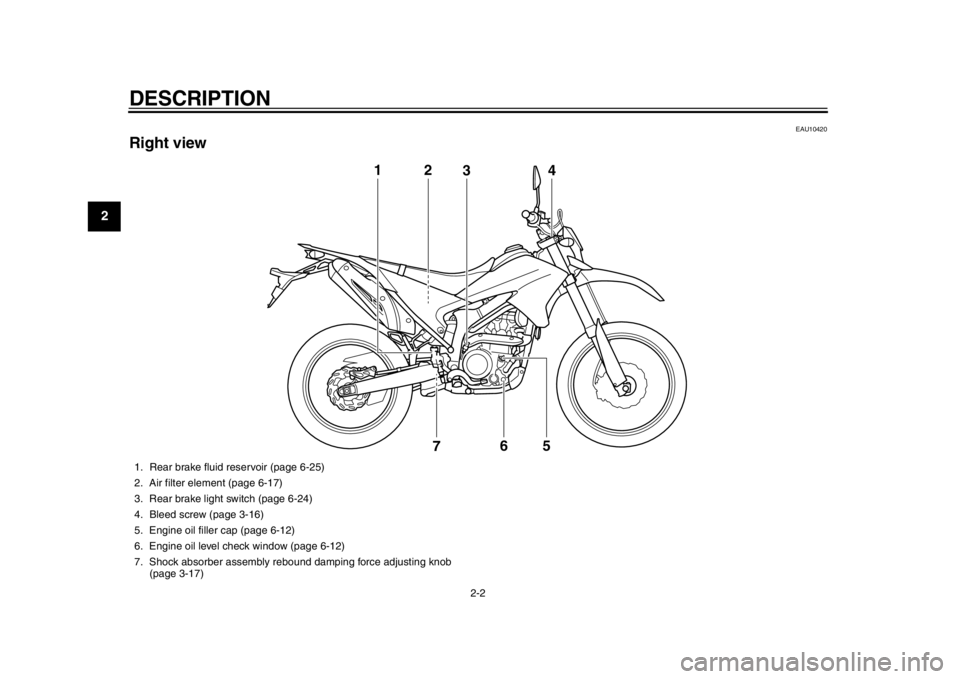
DESCRIPTION
2-2
12
3
4
5
6
7
8
9
EAU10420
Right view
3
1
2
7 6
5
4
1. Rear brake fluid reservoir (page 6-25)
2. Air filter element (page 6-17)
3. Rear brake light switch (page 6-24)
4. Bleed screw (page 3-16)
5. Engine oil filler cap (page 6-12)
6. Engine oil level check window (page 6-12)
7. Shock absorber assembly rebound damping force adjusting knob
(page 3-17)
32D-9-E8.book 2 ページ 2011年6月28日 火曜日 午前10時27分
Page 16 of 98
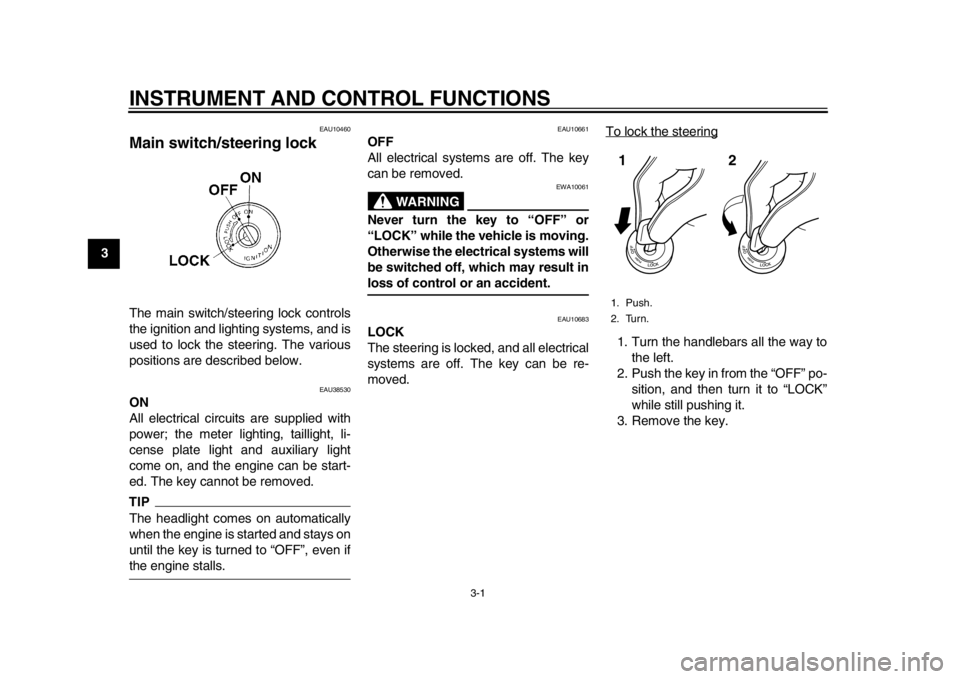
3-1
1
23
4
5
6
7
8
9
INSTRUMENT AND CONTROL FUNCTIONS
EAU10460
Main switch/steering lock The main switch/steering lock controls
the ignition and lighting systems, and is
used to lock the steering. The various
positions are described below.
EAU38530
ON
All electrical circuits are supplied with
power; the meter lighting, taillight, li-
cense plate light and auxiliary light
come on, and the engine can be start-
ed. The key cannot be removed.TIPThe headlight comes on automatically
when the engine is started and stays on
until the key is turned to “OFF”, even ifthe engine stalls.
EAU10661
OFF
All electrical systems are off. The key
can be removed.
WARNING
EWA10061
Never turn the key to “OFF” or
“LOCK” while the vehicle is moving.
Otherwise the electrical systems will
be switched off, which may result inloss of control or an accident.
EAU10683
LOCK
The steering is locked, and all electrical
systems are off. The key can be re-
moved. To lock the steering
1. Turn the handlebars all the way to
the left.
2. Push the key in from the “OFF” po- sition, and then turn it to “LOCK”
while still pushing it.
3. Remove the key.1. Push.
2. Turn.12
32D-9-E8.book 1 ページ 2011年6月28日 火曜日 午前10時27分
Page 17 of 98
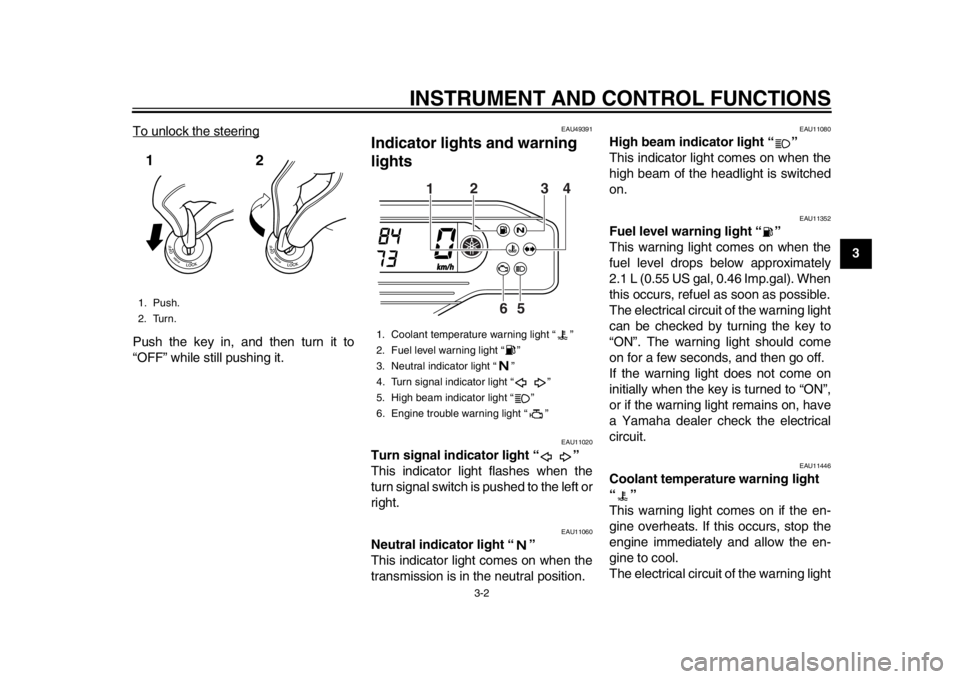
INSTRUMENT AND CONTROL FUNCTIONS
3-2
234
5
6
7
8
9
To unlock the steering
Push the key in, and then turn it to
“OFF” while still pushing it.
EAU49391
Indicator lights and warning
lights
EAU11020
Turn signal indicator light “ ”
This indicator light flashes when the
turn signal switch is pushed to the left or
right.
EAU11060
Neutral indicator light “ ”
This indicator light comes on when the
transmission is in the neutral position.
EAU11080
High beam indicator light “ ”
This indicator light comes on when the
high beam of the headlight is switched
on.
EAU11352
Fuel level warning light “ ”
This warning light comes on when the
fuel level drops below approximately
2.1 L (0.55 US gal, 0.46 Imp.gal). When
this occurs, refuel as soon as possible.
The electrical circuit of the warning light
can be checked by turning the key to
“ON”. The warning light should come
on for a few seconds, and then go off.
If the warning light does not come on
initially when the key is turned to “ON”,
or if the warning light remains on, have
a Yamaha dealer check the electrical
circuit.
EAU11446
Coolant temperature warning light
“”
This warning light comes on if the en-
gine overheats. If this occurs, stop the
engine immediately and allow the en-
gine to cool.
The electrical circuit of the warning light
1. Push.
2. Turn.12
1. Coolant temperature warning light “ ”
2. Fuel level warning light “ ”
3. Neutral indicator light “ ”
4. Turn signal indicator light “ ”
5. High beam indicator light “ ”
6. Engine trouble warning light “ ”
1
234
56
32D-9-E8.book 2 ページ 2011年6月28日 火曜日 午前10時27分
Page 18 of 98

INSTRUMENT AND CONTROL FUNCTIONS
3-3
1
23
4
5
6
7
8
9can be checked by turning the key to
“ON”. The warning light should come
on for a few seconds, and then go off.
If the warning light does not come on
initially when the key is turned to “ON”,
or if the warning light remains on, have
a Yamaha dealer check the electrical
circuit.
NOTICE
ECA10021
Do not continue to operate the en-gine if it is overheating.TIP
For radiator-fan-equipped vehi-
cles, the radiator fan(s) automati-
cally switch on or off according to
the coolant temperature in the ra-
diator.
If the engine overheats, see page6-44 for further instructions.
EAU11534
Engine trouble warning light “ ”
This warning light comes on or flashes
if a problem is detected in the electrical
circuit monitoring the engine. If this oc-
curs, have a Yamaha dealer check the
self-diagnosis system. (See page 3-8 for an explanation of the self-diagnosis
device.)
The electrical circuit of the warning light
can be checked by turning the key to
“ON”. The warning light should come
on for a few seconds, and then go off.
If the warning light does not come on
initially when the key is turned to “ON”,
or if the warning light remains on, have
a Yamaha dealer check the electrical
circuit.
EAU45276
Multi-function display
WARNING
EWA12312
Be sure to stop the vehicle before
making any setting changes to the
multi-function display. Changing
settings while riding can distract the
operator and increase the risk of anaccident.1. “RESET” button
2. “SELECT 1” button
3. “SELECT 2” button
4. Clock/stopwatch
5. Speedometer
6. Odometer/tripmeter/fuel reserve tripmeter
1
23
4
5
6
32D-9-E8.book 3 ページ 2011年6月28日 火曜日 午前10時27分
Page 23 of 98

INSTRUMENT AND CONTROL FUNCTIONS
3-8
234
5
6
7
8
9
2. Reset the distance-compensation
tripmeter to zero by pushing the
“RESET” button for at least two
seconds.
Resetting the distance-compensation
tripmeter in combination with the stop-watch1. Stop the stopwatch.
2. Reset the distance-compensation tripmeter and the stopwatch to
zero by pushing the “RESET” but-
ton for at least two seconds.
Self-diagnosis device
This model is equipped with a self-diag-
nosis device for vari ous electrical cir-
cuits.
If a problem is detected in any of those
circuits, the engine trouble warning light
will come on and the display will indi-
cate an error code.
If the display indicates any error codes,
note the code number, and then have a
Yamaha dealer check the vehicle.
NOTICE
ECA11590
If the display indicates an error
code, the vehicle should be checked
as soon as possible in order to avoidengine damage.
EAU12348
Handlebar switches Left
Right
1. Error code display
1
1. Dimmer switch “ / ”
2. Turn signal switch “ / ”
3. Horn switch “ ”
1. Engine stop switch “ / ”
2. Start switch “ ”
1
2
31
2
32D-9-E8.book 8 ページ 2011年6月28日 火曜日 午前10時27分
Page 24 of 98
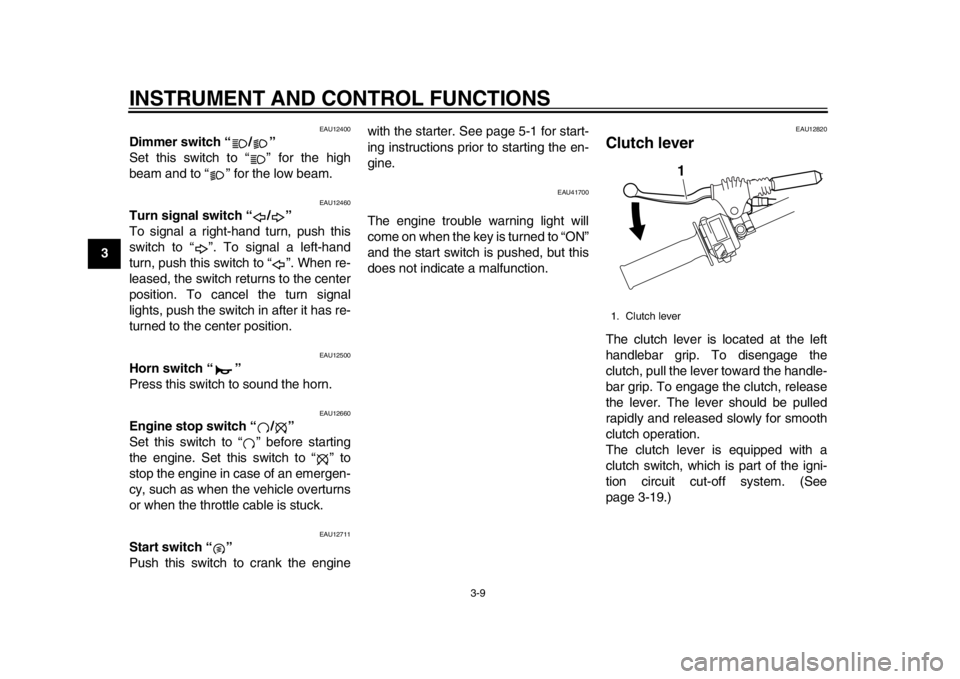
INSTRUMENT AND CONTROL FUNCTIONS
3-9
1
23
4
5
6
7
8
9
EAU12400
Dimmer switch “ / ”
Set this switch to “ ” for the high
beam and to “ ” for the low beam.
EAU12460
Turn signal switch “ / ”
To signal a right-hand turn, push this
switch to “ ”. To signal a left-hand
turn, push this switch to “ ”. When re-
leased, the switch returns to the center
position. To cancel the turn signal
lights, push the switch in after it has re-
turned to the center position.
EAU12500
Horn switch “ ”
Press this switch to sound the horn.
EAU12660
Engine stop switch “ / ”
Set this switch to “ ” before starting
the engine. Set this switch to “ ” to
stop the engine in case of an emergen-
cy, such as when the vehicle overturns
or when the throttle cable is stuck.
EAU12711
Start switch “ ”
Push this switch to crank the enginewith the starter. See page 5-1 for start-
ing instructions prior to starting the en-
gine.
EAU41700
The engine trouble warning light will
come on when the key is turned to “ON”
and the start switch is pushed, but this
does not indicate a malfunction.
EAU12820
Clutch lever The clutch lever is located at the left
handlebar grip. To disengage the
clutch, pull the lever toward the handle-
bar grip. To engage the clutch, release
the lever. The lever should be pulled
rapidly and released slowly for smooth
clutch operation.
The clutch lever is equipped with a
clutch switch, which is part of the igni-
tion circuit cut-off system. (See
page 3-19.)1. Clutch lever
1
32D-9-E8.book 9 ページ 2011年6月28日 火曜日 午前10時27分
Page 26 of 98
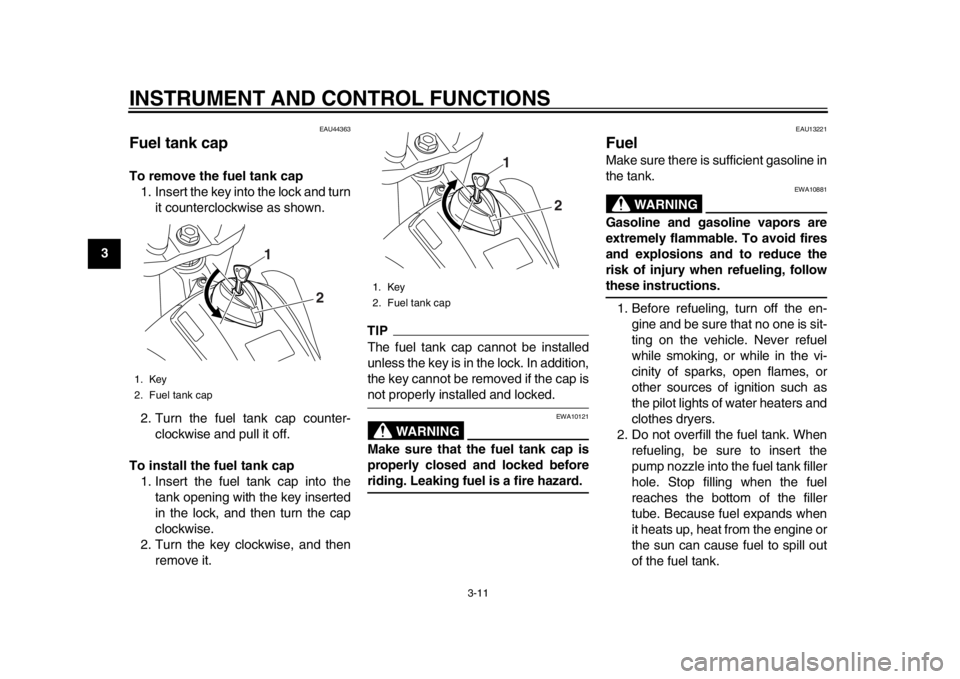
INSTRUMENT AND CONTROL FUNCTIONS
3-11
1
23
4
5
6
7
8
9
EAU44363
Fuel tank cap To remove the fuel tank cap1. Insert the key into the lock and turn it counterclockwise as shown.
2. Turn the fuel tank cap counter- clockwise and pull it off.
To install the fuel tank cap 1. Insert the fuel tank cap into the tank opening with the key inserted
in the lock, and then turn the cap
clockwise.
2. Turn the key clockwise, and then remove it.
TIPThe fuel tank cap cannot be installed
unless the key is in the lock. In addition,
the key cannot be removed if the cap isnot properly installed and locked.
WARNING
EWA10121
Make sure that the fuel tank cap is
properly closed and locked beforeriding. Leaking fuel is a fire hazard.
EAU13221
Fuel Make sure there is sufficient gasoline in
the tank.
WARNING
EWA10881
Gasoline and gasoline vapors are
extremely flammable. To avoid fires
and explosions and to reduce the
risk of injury when refueling, followthese instructions.
1. Before refueling, turn off the en- gine and be sure that no one is sit-
ting on the vehicle. Never refuel
while smoking, or while in the vi-
cinity of sparks, open flames, or
other sources of ignition such as
the pilot lights of water heaters and
clothes dryers.
2. Do not overfill the fuel tank. When refueling, be sure to insert the
pump nozzle into the fuel tank filler
hole. Stop filling when the fuel
reaches the bottom of the filler
tube. Because fuel expands when
it heats up, heat from the engine or
the sun can cause fuel to spill out
of the fuel tank.
1. Key
2. Fuel tank cap
1
2
1. Key
2. Fuel tank cap
1
2
32D-9-E8.book 11 ページ 2011年6月28日 火曜日 午前10時27分